Some problems of tyre control
Page 59

If you've noticed an error in this article please click here to report it so we can fix it.
ONCE the major part of a general haulage fleet has changed over from tramp to trunk services, and the onedriver-one-vehicle situation has ceased to be, an assortment of problems rear their heads in connection with tyre economies and control.
Operating balanced trunk services calls for day and night drivers, and it may he that a part of this team will belong to another company, and not come under the direct control of the owning company. Thus the normally reliable reports of the one tramp driver can be gone for good, being replaced by secondor third-hand information not always supported by workable documentation.
Again, the tramp driver invariably carried his own spare wheel and tools. Unless troubled by a second failure on a particular journey, he was able to take care of his own tyre problems, bringing the evidence home with him. If a tyre had to be purchased, the advice note and the old tyre came back with him, with management now fully in the picture.
With trunk however, and its several drivers on the one vehicle, or the articulated outfit with one driver but trailers
to change over, a very different situation may exist, expensive, and frustrating any easy approach to workable tyre control.
On many motive units and trailers too, the spare wheel and its heavy carrier have been dispensed with, bringing about a saving in unladen weight on the one hand, and on the other, removing the constant problem of lost tools, jack, wheel keys and bars, this latter feature a known expensive one.
If good inflation attention can be given pre-journey, it is true that tyre troubles during the journey will be few indeed. Many operators who have discarded spare wheels and tools now rely upon the tyre agent for after-hour repairs or replacements. This scheme can work quite well, but it does present problems for the engineer trying to keep accurate tyre records. Quite often the removed tyre cannot be brought home because there is no room for it so it can be lost for some time or even for good.
The second problem is advice of supply, and again, this slip of paper often fails to turn up in time for any useful action, and it is quite normal for the invoice to arrive first, there is a bill to pay with no real proof of supply, or whether or not there was still life left in the old cover. This is not a reflection of the agents in any way, it is simply a weakness that can exist in the flow of information between incident and engineer.
Quite often the tyre change is made overnight, the tyre man being on call and usually bringing with him a new tyre, tube and flap. If the new tyre is fitted and there is no place to load the removed cover to bring it home, the task of accurately recording details of the removed tyre is not as easy as it may seem. Quite often the tyre number finally received bears little resemblance to that of any tyre on the vehicle or trailer record, and the life history of the removed tyre is in doubt.
Not helping in this is the fact that rncx tyres are numbered on the one wall on13 and where kerbing has caught that side c the tyre, the number can be almost obi terated. The fact that a check is regularl needed at home base is again hampered b a single number on one side, and the need t part twin wheels to check. During tyr inspection at home base, and during an visual check on tyre numbers around th vehicle, this problem of numbers out c sight between wheels is often the cause c guesswork, or an attempt to decipher thei with a mirror.
I find one of the most reliable methoc of obtaining a tyre number under suc conditions, or in any other circumstanc( where a true record is important, is t place a sheet of plain white paper over th area of the number, and take a rubbin with black crayon. This will outline exact] the letters and numbers, and if there is an doubt anywhere, this rubbing can be use or even posted on as absolute proof. Wit tyres paired quite close together I hal found that if a black crayon can be insertc between, a sheet of paper taped in plac and a rubbing taken in minutes.
The alternative would be for mans facturers to emboss the data on both wal of the tyre.
































































































































